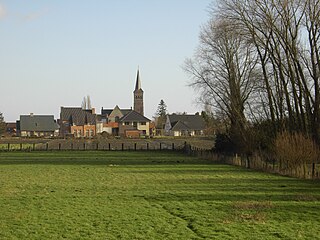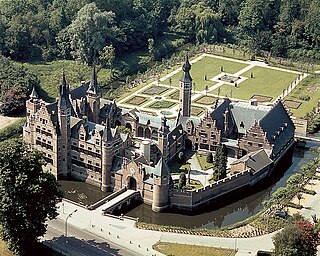
Heusden is a municipality and a town in the South of the Netherlands. It is located between the towns of Waalwijk and 's-Hertogenbosch. The municipality of Heusden, including Herpt, Heesbeen, Hedikhuizen, Doeveren, and Oudheusden, merged with Drunen and Vlijmen in 1997, giving the municipality its current form.

Lokeren is a municipality located in the Belgian province of East Flanders, and belongs to the Waasland, also called Land van Waas, of which it is the second most important city after Sint-Niklaas. The city, located on the river Durme, the Lede, and the E17 motorway, has more than 42,100 inhabitants, who are called Lokeraars or Rapenfretters. Because Lokeren is located on the Durme, Lokeren is often called "The Durme City". Horse sausages are officially recognized as a regional product.

Heusden was a municipality located in the Belgian province of East Flanders. In 1977 it merged with the municipality of Destelbergen, of which it is now part.

Bronkhorst is a village in the municipality of Bronckhorst, Gelderland, the Netherlands. Technically, it is a city and with only 157 inhabitants (2010), it is one of the smallest cities in the Netherlands.

The House of Egmond or Egmont is named after the Dutch town of Egmond, province of North Holland, and played an important role in the Netherlands during the Middle Ages.

Lieshout is a small village located in the province of North Brabant in the south of the Netherlands, about 15 kilometres northeast of Eindhoven. There are 4,300 inhabitants, and the village is known for its brewing company Swinkels Family Brewers. The spoken language is Peellands.

Beverston Castle, also known as Beverstone Castle or Tetbury Castle, was constructed as a medieval stone fortress in the village of Beverston, Gloucestershire, England. The property is a mix of manor house, various small buildings, extensive gardens and the medieval ruins of the fortified building. The castle was founded in 1229 by Maurice de Gaunt.

Andon is a commune in the Alpes-Maritimes department in the Provence-Alpes-Côte d'Azur region of southeastern France.

Alloue is a commune in the Charente department in the Nouvelle-Aquitaine region of southwestern France.

Jemeppe Castle, also known as Hargimont Castle, is a castle in Hargimont, now part of the municipality of Marche-en-Famenne, province of Luxembourg, Wallonia, Belgium.

Vosselare is a submunicipality and parish of the community of Nevele, Belgium.

Ter Worm or Terworm Castle is a castle located in the municipality of Heerlen, Limburg Province, Netherlands. The castle is part of the Terworm estate.

The Sterckshof castle is in Deurne, Antwerp, Belgium. From 1994 to 2014 it housed the Sterckshof silver museum of the Province of Antwerp. Built on the site of a much older castle, or great house, the present building is a reconstruction erected in the 1920s.

Eijsden Castle is a moated manor house with several farm buildings, a gatehouse and castle park, in Eijsden-Margraten, Limburg, Netherlands. The current castle was built in 1637 and is located next to the river Maas.

Couwelaar Castle, also known as De Drie Torekens, is a castle in the Deurne district of Antwerp. The castle is L-shaped and consists of a main building with wings, as well as several outbuildings including a coach house. The main building is characterized by two round towers at the front and a built-in, square tower at the rear. Over the centuries, the castle has been extensively altered and restored several times and has stylistic elements of the Neo-Renaissance and Rococo, among others. Couwelaar Castle is a historical monument.

Oud Herlaer was a castle on the Dommel just east of Vught. All that remains is a farm which incorporates parts of the old castle. While not that much remains of the castle, there are a lot of recent studies about Oud Herlaer and its owners. The farm is planned to be opened as an art center in 2021. The name Oud Herlaer,, signifies that later on Nieuw-Herlaer Castle was built about 1 kilometer upstream.

Oud Haerlem Castle was a very strong castle in Holland. In 1351 it was demolished after a long siege.

Heusden Castle is a historical site and castle in Heusden, Destelbergen, Belgium. The present structure was built in 1899 on the grounds of a former castle built in the 11th century. The above ground parts of the old castle were demolished in the 18th century. The moat of the old castle still exist. In 1911, remains of what were probably dungeons were found, and parts of an older building near the moat were restored.

Ocket Castle is a house, on the site of a castle, in Heusden, Destelbergen, East Flanders, Belgium. It probably originated on the former fief of Grooten Hoek that lasted until the 15th century. The castle was depicted on a 1725 map by PJ Benthuys as a building with a moat near the Scheldt and is mentioned in 1767 as a "partije genaemt den grieten hoeck met de mote ende huys van playsance". The present Neoclassical building dates largely from the 18th and 19th centuries but contains a dining room on the east side that in the 17th/18th century was the core of the structure, as was established among other things from the beams and the Rococo stucco decorations.

Te Riviere Castle is a ruinous castle located in Schiedam, Netherlands.




















